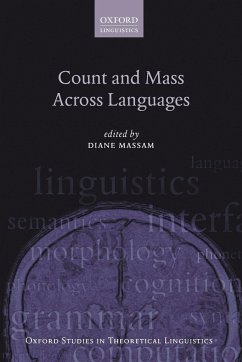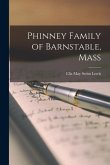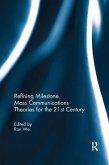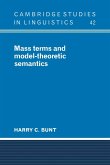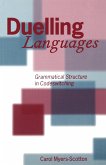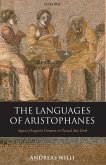Count and Mass Across Languages
Herausgeber: Massam, Diane
Count and Mass Across Languages
Herausgeber: Massam, Diane
- Broschiertes Buch
- Merkliste
- Auf die Merkliste
- Bewerten Bewerten
- Teilen
- Produkt teilen
- Produkterinnerung
- Produkterinnerung
This volume explores the expression of the concepts count and mass in human language and probes the complex relation between seemingly incontrovertible aspects of meaning and their varied grammatical realizations across languages.
Andere Kunden interessierten sich auch für
![Phinney Family of Barnstable, Mass Phinney Family of Barnstable, Mass]() Phinney Family of Barnstable, Mass14,99 €
Phinney Family of Barnstable, Mass14,99 €![Fluffy the Vulture & Count Ten, Fluffy the Vulture 2 in 1 Fluffy the Vulture & Count Ten, Fluffy the Vulture 2 in 1]() William ZickerFluffy the Vulture & Count Ten, Fluffy the Vulture 2 in 131,99 €
William ZickerFluffy the Vulture & Count Ten, Fluffy the Vulture 2 in 131,99 €![The Strategies of Martin Luther King, Jr. and Malcolm X in the Course of the Mass African-American Protest of the Early 1960s The Strategies of Martin Luther King, Jr. and Malcolm X in the Course of the Mass African-American Protest of the Early 1960s]() Stefan KüpperThe Strategies of Martin Luther King, Jr. and Malcolm X in the Course of the Mass African-American Protest of the Early 1960s15,95 €
Stefan KüpperThe Strategies of Martin Luther King, Jr. and Malcolm X in the Course of the Mass African-American Protest of the Early 1960s15,95 €![Refining Milestone Mass Communications Theories for the 21st Century Refining Milestone Mass Communications Theories for the 21st Century]() Refining Milestone Mass Communications Theories for the 21st Century63,99 €
Refining Milestone Mass Communications Theories for the 21st Century63,99 €![Mass Terms and Model-Theoretic Semantics Mass Terms and Model-Theoretic Semantics]() Harry C. BuntMass Terms and Model-Theoretic Semantics48,99 €
Harry C. BuntMass Terms and Model-Theoretic Semantics48,99 €![Duelling Languages Duelling Languages]() Carol Myers-ScottonDuelling Languages71,99 €
Carol Myers-ScottonDuelling Languages71,99 €![The Languages of Aristophanes The Languages of Aristophanes]() Andreas WilliThe Languages of Aristophanes80,99 €
Andreas WilliThe Languages of Aristophanes80,99 €-
-
-
This volume explores the expression of the concepts count and mass in human language and probes the complex relation between seemingly incontrovertible aspects of meaning and their varied grammatical realizations across languages.
Produktdetails
- Produktdetails
- Verlag: OUP Oxford
- Seitenzahl: 332
- Erscheinungstermin: 13. September 2012
- Englisch
- Abmessung: 234mm x 156mm x 18mm
- Gewicht: 506g
- ISBN-13: 9780199654284
- ISBN-10: 019965428X
- Artikelnr.: 35275552
- Herstellerkennzeichnung
- Libri GmbH
- Europaallee 1
- 36244 Bad Hersfeld
- gpsr@libri.de
- Verlag: OUP Oxford
- Seitenzahl: 332
- Erscheinungstermin: 13. September 2012
- Englisch
- Abmessung: 234mm x 156mm x 18mm
- Gewicht: 506g
- ISBN-13: 9780199654284
- ISBN-10: 019965428X
- Artikelnr.: 35275552
- Herstellerkennzeichnung
- Libri GmbH
- Europaallee 1
- 36244 Bad Hersfeld
- gpsr@libri.de
Diane Massam is Professor of Linguistics at the University of Toronto where she served as Chair of Linguistics from 2002 to 2008. Her research focus is on syntactic theory, in the areas of argument structure, case, predication, and word order, working mainly on Niuean, a Polynesian language. She is the co-editor of Ergativity: Emerging issues (Springer 2006) and has published papers in many journals such as Lingua, Oceanic Linguistics, Natural Language and Linguistic Theory, English Language and Linguistics, and Syntax. She has held several research grants from the Social Sciences and Humanities Research Council of Canada, and was co-editor of Squibs for Linguistic Inquiry (1998-2002), honorary research fellow at the University of Auckland (2001), visiting professor at Harvard University (2006), and an Erskine Fellow at the University of Canterbury, New Zealand (2010).
* 1: Jila Ghomeshi and Diane Massam: The Count Mass Distinction: Issues
and Perspectives
* 2: Francis Jeffry Pelletier: Lexical Nouns are Both +MASS and +COUNT,
but They are Neither +MASS nor +COUNT
* 3: Elizabeth Cowper and Daniel Currie Hall: Aspects of Individuation
* 4: Heike Wiese: Collectives in the Intersection of Mass and Count
Nouns: A Cross-Linguistic Account
* 5: Scott Grimm: Individuation and Inverse Number Marking in Dagaare
* 6: Ileana Paul: General Number and the Structure of DP
* 7: Saeed Ghaniabadi: Plural Marking Beyond Count Nouns
* 8: Solveiga Armoskaite: Aspectual Effects of a Pluractional Suffix:
Evidence From Lithuanian
* 9: Martina Wiltschko: Decomposing the Mass/count Distinction:
Evidence from Languages that Lack it
* 10: Eric Mathieu: On the Mass/count Distinction in Ojibwe
* 11: Lisa Lai-Shen Cheng: Counting and Classifiers
* 12: Niina Ning Zhang: Countability and Numeral Classifiers in
Mandarin Chinese
* 13: Alan C. Bale and David Barner: Semantic Triggers, Linguistic
Variation, and the Mass-Count Distinction
* 14: Natalie M. Klein, Greg N. Carlson, Renjie Li, T. Florian Jaeger,
and Michael K. Tanenhaus: Classifying and Massifying Incrementally in
Chinese Language Comprehension
* References
* Index
and Perspectives
* 2: Francis Jeffry Pelletier: Lexical Nouns are Both +MASS and +COUNT,
but They are Neither +MASS nor +COUNT
* 3: Elizabeth Cowper and Daniel Currie Hall: Aspects of Individuation
* 4: Heike Wiese: Collectives in the Intersection of Mass and Count
Nouns: A Cross-Linguistic Account
* 5: Scott Grimm: Individuation and Inverse Number Marking in Dagaare
* 6: Ileana Paul: General Number and the Structure of DP
* 7: Saeed Ghaniabadi: Plural Marking Beyond Count Nouns
* 8: Solveiga Armoskaite: Aspectual Effects of a Pluractional Suffix:
Evidence From Lithuanian
* 9: Martina Wiltschko: Decomposing the Mass/count Distinction:
Evidence from Languages that Lack it
* 10: Eric Mathieu: On the Mass/count Distinction in Ojibwe
* 11: Lisa Lai-Shen Cheng: Counting and Classifiers
* 12: Niina Ning Zhang: Countability and Numeral Classifiers in
Mandarin Chinese
* 13: Alan C. Bale and David Barner: Semantic Triggers, Linguistic
Variation, and the Mass-Count Distinction
* 14: Natalie M. Klein, Greg N. Carlson, Renjie Li, T. Florian Jaeger,
and Michael K. Tanenhaus: Classifying and Massifying Incrementally in
Chinese Language Comprehension
* References
* Index
* 1: Jila Ghomeshi and Diane Massam: The Count Mass Distinction: Issues
and Perspectives
* 2: Francis Jeffry Pelletier: Lexical Nouns are Both +MASS and +COUNT,
but They are Neither +MASS nor +COUNT
* 3: Elizabeth Cowper and Daniel Currie Hall: Aspects of Individuation
* 4: Heike Wiese: Collectives in the Intersection of Mass and Count
Nouns: A Cross-Linguistic Account
* 5: Scott Grimm: Individuation and Inverse Number Marking in Dagaare
* 6: Ileana Paul: General Number and the Structure of DP
* 7: Saeed Ghaniabadi: Plural Marking Beyond Count Nouns
* 8: Solveiga Armoskaite: Aspectual Effects of a Pluractional Suffix:
Evidence From Lithuanian
* 9: Martina Wiltschko: Decomposing the Mass/count Distinction:
Evidence from Languages that Lack it
* 10: Eric Mathieu: On the Mass/count Distinction in Ojibwe
* 11: Lisa Lai-Shen Cheng: Counting and Classifiers
* 12: Niina Ning Zhang: Countability and Numeral Classifiers in
Mandarin Chinese
* 13: Alan C. Bale and David Barner: Semantic Triggers, Linguistic
Variation, and the Mass-Count Distinction
* 14: Natalie M. Klein, Greg N. Carlson, Renjie Li, T. Florian Jaeger,
and Michael K. Tanenhaus: Classifying and Massifying Incrementally in
Chinese Language Comprehension
* References
* Index
and Perspectives
* 2: Francis Jeffry Pelletier: Lexical Nouns are Both +MASS and +COUNT,
but They are Neither +MASS nor +COUNT
* 3: Elizabeth Cowper and Daniel Currie Hall: Aspects of Individuation
* 4: Heike Wiese: Collectives in the Intersection of Mass and Count
Nouns: A Cross-Linguistic Account
* 5: Scott Grimm: Individuation and Inverse Number Marking in Dagaare
* 6: Ileana Paul: General Number and the Structure of DP
* 7: Saeed Ghaniabadi: Plural Marking Beyond Count Nouns
* 8: Solveiga Armoskaite: Aspectual Effects of a Pluractional Suffix:
Evidence From Lithuanian
* 9: Martina Wiltschko: Decomposing the Mass/count Distinction:
Evidence from Languages that Lack it
* 10: Eric Mathieu: On the Mass/count Distinction in Ojibwe
* 11: Lisa Lai-Shen Cheng: Counting and Classifiers
* 12: Niina Ning Zhang: Countability and Numeral Classifiers in
Mandarin Chinese
* 13: Alan C. Bale and David Barner: Semantic Triggers, Linguistic
Variation, and the Mass-Count Distinction
* 14: Natalie M. Klein, Greg N. Carlson, Renjie Li, T. Florian Jaeger,
and Michael K. Tanenhaus: Classifying and Massifying Incrementally in
Chinese Language Comprehension
* References
* Index

